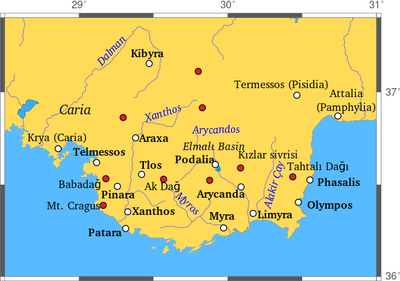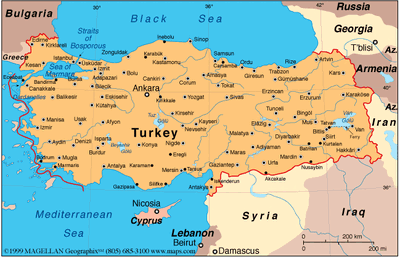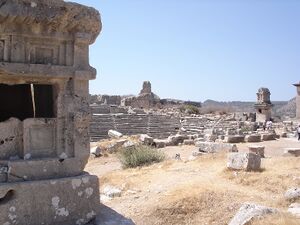Xanthos
| Author: Laxman Burdak, IFS (R). |


Xanthos was the name of a city in ancient Lycia, the site of present-day Kınık, Antalya Province, Turkey, and of the Xanthus River on which the city is situated.
Location
The ruins of Xanthus are on the south slopes of a hill, the ancient acropolis, located on the northern outskirts of the modern city, on the left bank of the Xanthus, which flows beneath the hill. A single road, Xantos yolu, encircles the hill and runs through the ruins.
Variants of name
- Xanthus (Anabasis by Arrian,p. 67.)
- Arinna/Arñna (Lycian: 𐊀𐊕𐊑𐊏𐊀)
- Xanthos Ξάνθος (Greek) (Arrian[1])
- Xanthos River(Arrian[2])
- Xanthus (Latin) (Pliny.vi.39)
- Ksantos (Turkish)
- Sibros/Sibris/ Sivrisi (Strabo original name of the river)
- Siyanti (Hittite)
Jat Gotras Namesake
- Jats = Xanthus (Anabasis by Arrian,p. 67.). Xanthus is variant of Jats in Greek. Xanthus is the Greek variant of Jat and its latinazed form is Xanthos. They also gave name to the River called Xanthus River.
History
Xanthos is the Greek appellation of Arñna, a city originally speaking the Lycian language. The Hittite and Luwian name of the city is given in inscriptions as Arinna (not to be confused with the Arinna near Hattusa). Xanthos is a Greek name, acquired during its Hellenization. The Romans called the city Xanthus, as all the Greek -os suffixes were changed to -us in Latin. Xanthos was a center of culture and commerce for the Lycians, and later for the Persians, Greeks and Romans who in turn conquered the city and occupied the adjacent territory. As Xanthus, the former Byzantine bishopric remains a Latin Catholic titular see. After the fall of the Byzantine Empire in the 15th century, the region became Turkish. The ancient city had long since been abandoned.

Trojan War heroes and Lycian leaders Glaucus and Sarpedon are described in the Iliad as coming from the land of the Xanthos River. In the same text, Achilles' immortal, talking horse is named Xanthos. Xanthus is mentioned by numerous ancient Greek and Roman writers. Strabo notes Xanthos as the largest city in Lycia.
Under the Persian Empire: Both Herodotus and Appian describe the conquest of the city by Harpagus on behalf of the Persian Empire, in approximately 540 BC. According to Herodotus, the Persians met and defeated a small Lycian army in the flatlands to the north of the city. After the encounter, the Lycians retreated into the city which was besieged by Harpagus. The Lycians destroyed their own Xanthian acropolis, killed their wives, children, and slaves, then proceeded on a suicidal attack against the superior Persian troops. Thus, the entire population of Xanthos perished but for 80 families who were absent during the fighting.
During the Persian occupation, a local leadership was installed at Xanthos, which by 520 BC was already minting its own coins. By 516 BC, Xanthos was included in the first nomos of Darius I in the tribute list.
Xanthos' fortunes were tied to Lycia's as Lycia changed sides during the Greco-Persian Wars.
Archeological digs demonstrate that Xanthos was destroyed in approximately 475 BC-470 BC; whether this was done by the Athenian Kimon or by the Persians is open to debate. As we have no reference to this destruction in either Persian or Greek sources, some scholars attribute the destruction to natural or accidental causes. Xanthos was rebuilt after the destruction and in the final decades of the 5th century BC, Xanthos conquered nearby Telmessos and incorporated it into Lycia.
The prosperity of Lycia during the Persian occupation is demonstrated by the extensive architectural achievements in Xanthos, particularly the many tombs, culminating in the Nereid Monument.
Conquest by Alexander the Great : Reports on the city's surrender to Alexander the Great differ: Arrian reports a peaceful surrender, but Appian claims that the city was sacked. Arrian[3] writes....He (Alexander) himself marched towards Lycia and Pamphylia, in order to gain command of the coast-land, and by that means render the enemy's fleet useless. The first place on his route was Hyparna, a strong position, having a garrison of Grecian mercenaries; but he took it at the first assault, and allowed the Greeks to depart from the citadel under a truce. Then he invaded Lycia and brought over the Telmissians by capitulation; and crossing the River Xanthus, the cities of Pinara, Xanthus, Patara, and about thirty other smaller towns were surrendered to him. ....The Marmarians alone defended their city with desperate valour. They finally set fire to it, and escaped through the Macedonian camp to the mountains. [4]
After Alexander's death, the city changed hands among his rival heirs; Diodorus notes the capture of Xanthos by Ptolemy I Soter from Antigonos.
Roman and Byzantine rule: Appian, Dio Cassius, and Plutarch each report that city was once again destroyed in the Roman Civil Wars, circa 42 BC, by Brutus, but Appian notes that it was rebuilt under Mark Antony. Remains of a Roman amphitheater remain on the site. Marinos reports that there was a school of grammarians at Xanthos in late antiquity. Xanthus was in the Roman province of Lycia, in the civil Diocese of Asia.
Acquisition of Lycia by Cyrus the Great
Herodotus writes more credibly of contemporaneous events, especially where they concerned his native land. Asia Minor had been partly conquered by the Iranians, starting with the Scythians, then the Medes. The latter were defeated by the Persians, who incorporated them and their lands into the new Persian Empire. Cyrus the Great, founder of the Achaemenid dynasty, resolved to complete the conquest of Anatolia as a prelude to operations further west, to be carried out by his successors. He assigned the task to Harpagus, a Median general, who proceeded to subdue the various states of Anatolia, one by one, some by convincing them to submit, others through military action.
Arriving at the southern coast of Anatolia in 546 BC, the army of Harpagus encountered no problem with the Carians and their immediate Greek neighbors and alien populations, who submitted peacefully. In the Xanthus Valley an army of Xanthians sallied out to meet them, fighting determinedly, although vastly outnumbered. Driven into the citadel, they collected all their property, dependents and slaves into a central building, and burned them up. Then, after taking an oath not to surrender, they died to a man fighting the Persians, foreshadowing and perhaps setting an example for Spartan conduct at the Battle of Thermopylae a few generations later. Coincidentally archaeology has turned up a major fire on the acropolis of Xanthus in the mid-6th century BC, but as Antony Keen points out, there is no way to connect that fire with the event presented by Herodotus. It might have been another fire.[5] The Caunians, says Herodotus, followed a similar example immediately after.[6] If there was an attempt by any of the states of Lycia to join forces, as happened in Greece 50 years later, there is no record of it, suggesting that no central government existed. Each country awaited its own fate alone.
Herodotus also says or implies that 80 Xanthian families were away at the time, perhaps with the herd animals in alpine summer pastures , but helped repopulate the place. However, he reports, the Xanthians of his time were mainly descended from non-Xanthians. Looking for any nuance that might shed light on the re-population of Xanthus, Keen interprets Herodotus' "those Lycians who now say that they are Xanthians" to mean that Xanthus was repopulated by other Lycians (and not by Iranians or other foreigners).[7] Herodotus said nothing of the remainder of Lycia; presumably, that is true because they submitted without further incident. Lycia was well populated and flourished as a Persian satrapy; moreover, they spoke mainly Lycian.
Archaeology
As the center of ancient Lycia and the site of its most extensive antiquities, Xanthos has been a mecca for students of Anatolian civilization since the early 19th century. Many important artefacts were found at the city. Two tombs, the Nereid Monument and the Tomb of Payava, are now exhibited in the British Museum. The Harpy Tomb is still located in the ruins of the city. A sanctuary of Leto called the Letoon is located on the outskirts of the city to the southwest. The Xanthian Obelisk and the Letoon trilingual are two trilingual stelae which were found in the city and the Letoon. The site has been designated as a UNESCO World Heritage Site since 1988.
The archeological excavations and surface investigations at Xanthos have yielded many texts in Lycian and Greek, including bilingual texts that are useful in the understanding of Lycian. One monument, the Xanthian Obelisk, is a trilingual recording an older Anatolian language conventionally called Milyan language.
The River Xanthos
Strabo reports the original name of the river as Sibros or Sibris or Sivrisi. During the Persian invasion the river is called Sirbe which means "yellow" like the Greek word "xanthos", which also means yellow. The river usually has a yellow hue because of the soil in the alluvial base of the valley. Today the site of Xanthos overlooks the modern Turkish village of Kınık. Once over 500 m long, the Roman Kemer Bridge crossed the upper reaches of the river near the present-day village of Kemer. The modern Turkish name of the river is Eşen Çayı.
A Greek legend is that the river was created by the birth pangs of Leto, whose temple, at the Letoon, is on the west bank of the river a few kilometers south of Xanthos. The Letoon has been excavated in the 20th century, and has yielded numerous Lycian, Greek, and Aramaic texts. A notable trilingual text, known as the Letoon trilingual, in all three languages was found and has been found to contain a reference to King Artaxerxes. The Letoon has been designated as a UNESCO World Heritage Site.
Jat History
Hukum Singh Panwar (Pauria)[8] writes... Max Muller concluded that "the Indo-Aryans were, undoubtedly, a colony from northern India and the Schism took place when they migrated towards Persia", possibly under the leadership of Zarathushtra "who" according to Aristotle & Xanthos lived more than 6000 years before Plato. Zarathustra's floruit is stated to be from 7129 to.7052 B.C.[9]
According to Das, A.C.[10] 'Xanthos of Lydia, a contemporary of Artaxerxes (465-424 B.C.), places Zoroaster 6000 years before the expedition of Xerxes. Aristotle makes him 6000 years before the death of Plato. This date, however, is not accepted by modern European scholars. Hertel makes him live about 660-583 B.C.If that were so, Artaxerxes, who lived in the 5th century B.C.; would not have fixed Zoroaster's time about 6000 years before the expedition of Xerxes, and Aristotle could not have calculated a similar date. Zoroaster's date, however, has not yet been definitely settled, though the date of the classical writers closely tallies with Vedic chronology (Vide Keith's The Religion and Philosophy of the Vedas and Upnishadas. [11]
Ch 1.24 Alexander in Lycia and Pamphylia
Arrian[12] writes....Some of the Macedonians who served in Alexander's army had married just before he undertook the expedition. He thought that he ought not to treat these men with neglect, and therefore sent them back from Caria to spend the winter in Macedonia with their wives. He placed them under the command of Ptolemy, son of Seleucus, one of the royal body-guards, and of the two generals Coenus, son of Polemocrates, and Meleager, son of Neoptolemus, because they were also newly married. He gave these officers instructions to levy as many horse and foot soldiers as they could from the country, when they returned to him and brought back the men who had been sent away with them. By this act more than by any other Alexander acquired popularity among the Macedonians. He also sent Cleander, son of Polemocrates, to levy soldiers in Peloponnesus,[1] and Parmenio to Sardis, giving him the command of a regiment of the Cavalry Companions, the Thessalian cavalry, and the rest of the Grecian allies. He ordered him to take the wagons to Sardis and to advance from that place into Phrygia.
He himself marched towards Lycia and Pamphylia, in order to gain command of the coast-land, and by that means render the enemy's fleet useless. The first place on his route was Hyparna, a strong position, having a garrison of Grecian mercenaries; but he took it at the first assault, and allowed the Greeks to depart from the citadel under a truce. Then he invaded Lycia and brought over the Telmissians by capitulation; and crossing the River Xanthus, the cities of Pinara, Xanthus, Patara, and about thirty other smaller towns were surrendered to him.[2] Having accomplished this, though it was now the very depth of winter, he invaded the land called Milyas,[3] which is a part of Great Phrygia, but at that time paid tribute to Lycia, according to an arrangement made by the Great King. Hither came envoys from the Phaselites,[4] to treat for his friendship, and to crown him with a golden crown; and the majority of the maritime Lycians also sent heralds to him as ambassadors to treat for the same object. He ordered the Phaselites and Lycians to surrender their cities to those who were despatched by him to receive them; and they were all surrendered. He soon afterwards arrived himself at Phaselis, and helped the men of that city to capture a strong fort which had been constructed by the Pisidians to overawe the country; and sallying forth from which those barbarians used to inflict much damage upon the Phaselites who tilled the land.[5]
1. See Arrian, ii. 20 infra.
2. The Marmarians alone defended their city with desperate valour. They finally set fire to it, and escaped through the Macedonian camp to the mountains. See Diodorus (xvii. 28). As to Xanthus the river, see Homer (Iliad, ii. 877; vi. 172); Horace (Carm., iv. 6, 26).
3. Lycia was originally called Milyas; but the name was afterwards applied to the high table in the north of Lycia, extending into Pisidia. See Herodotus, i. 173.
4. Phaselis was a seaport of Lycia on the Gulf of Pamphylia. It is now called Tekrova.
5. He also crowned with garlands the statue of Theodectes the rhetorician, which the people of Phaselis, his native city, had erected to his memory. This man was a friend and pupil of Aristotle, the tutor of Alexander. See Plutarch (Life of Alex., 17); Aristotle (Nicom. Ethics, vii. 7).
References
- ↑ Arrian:The Anabasis of Alexander/1b, Ch.24
- ↑ Arrian:The Anabasis of Alexander/1b, Ch.24
- ↑ Arrian:The Anabasis of Alexander/1b, Ch.24
- ↑ See Diodorus (xvii. 28). As to Xanthus the river, see Homer (Iliad, ii. 877; vi. 172); Horace (Carm., iv. 6, 26).
- ↑ Keen & (1998), p. 73.
- ↑ Histories, Book I, Section 176.
- ↑ Keen & (1998), p. 76.
- ↑ The Jats:Their Origin, Antiquity and Migrations/The migrations of the Jats to the North-Western countries,p.232
- ↑ Spencer, H.S. : The Aryan Ecliptic Cycle, Poona-2, 1965;pp34,214
- ↑ Das, A.C.; Rigvedic India. p. 160, fn.1.
- ↑ Vo. II, Appendix A. pp. 614ff.1925. Dr. N.R. Warapande, Aryan Invasion- A Myth, Nagpur, 1989, pp. 192ff.
- ↑ Arrian:The Anabasis of Alexander/1b, Ch.24
Back to Jat Places in Turkey

